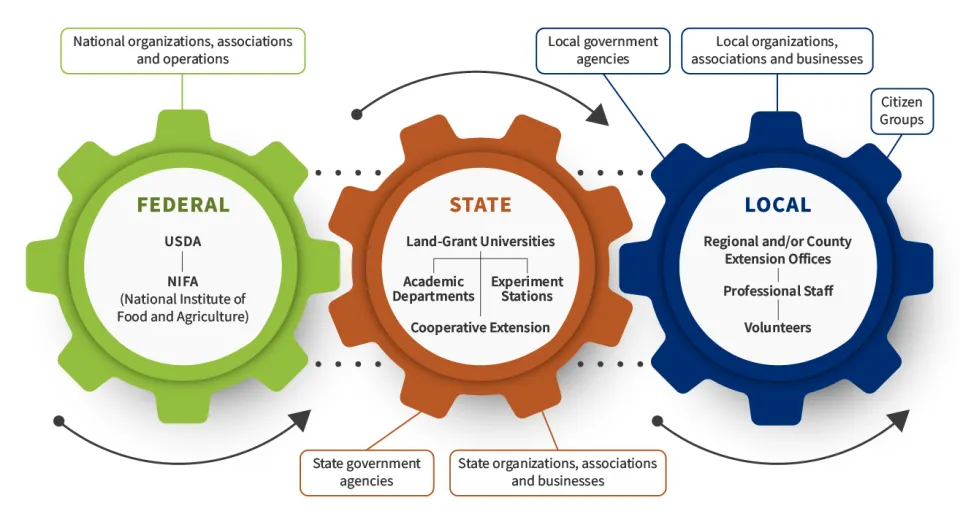
Nutrition Education
For more than a half century, the United States Department of Agriculture (USDA) – “the People’s Department” – has funded nutrition education designed to improve safe food handling and preparation as well as the nutritional health and well-being of the population. In addition to providing general guidance through resources such as MyPlate and the Dietary Guidelines for Americans, USDA provides more specific nutrition education through programs for historically underserved populations. USDA also funds research to increase understanding of healthful food and beverage choices and to refine and improve educational content, methodologies, and evaluation metrics.
Importance of Nutrition Education
Nutrition education has been described as any combination of educational strategies, accompanied by environmental supports, designed to motivate, and facilitate voluntary adoption of food choices and other food- and nutrition-related behaviors conducive to health and well-being. Nutrition education is delivered through multiple venues and involves activities at the individual, community, and policy levels. Nutrition education also addresses critical issues such as food and nutrition security, food scarcity, food literacy, and food sustainability (Isobel Contento and Pamela Koch (Nutrition Education: Linking Research, Theory, and Practice, Fourth Edition (2020)). From social ecological lens, effective nutrition education draws upon the collective strengths and contributions of individuals, families, communities, organizations, and other sectors of society to have its greatest potential to change eating behaviors, as well as advance health equity and well-being.
NIFA’s Impact
NIFA’s role in delivering high-quality nutrition education is a part of USDA’s four-pillar approach to Tackle Food and Nutrition Insecurity, one of the department’s current core priorities. In addition, NIFA’s contributions to improving nutrition education and the nutrition education workforce is highlighted in the historic White House Conference on Hunger, Nutrition, and Health and corresponding National Strategy, both of which aim to end hunger, improve nutrition and physical activity, and reduce diet-related diseases and disparities.
NIFA’s nutrition education program and research efforts are grounded in the Dietary Guidelines for Americans, Physical Activity Guidelines for Americans, and other federal food and nutrition guidelines and priorities. NIFA-funded programs are content and relationship-based, learner-centered, culturally relevant, and dynamic. Respect for lived experience is a core value of NIFA’s nutrition education programs. This is demonstrated by the vital role of peer educators and adaptation of content and methods to embrace differences in foods, learning styles, eating practices, languages, and family and community dynamics of those participating. Attention is also given to food costs, and to the shopping, preparation, safety, and storage of foods.
Evaluation is critical to the success of NIFA’s nutrition education portfolio. Evaluation of processes, progress, and outcomes allow participants and programs to recognize and celebrate success, identify gaps and barriers, raise research questions, and guide future program directions. The most recent EFNEP Impacts Report indicates the program reaches more than a half a million adults and families and more than 90% of adult EFNEP participants report improvement in what they eat each year. Similarly, the most recent GusNIP Year 3 Impacts Report demonstrated positive changes on participants’ fruit and vegetable intake and food security.
NIFA works closely with the Cooperative Extension System, other program partners, and grantees to ensure that nutrition education programming and the science that supports it leads to improved food and nutrition behaviors for improved health outcomes.

In addition, NIFA coordinates with other federal, tribal, state, and local agencies in addition to a variety of organizations including professional societies and non-profit organizations to facilitate improved nutritional health and well-being across different sectors of society. Examples include but are not limited to:
- Other federal nutrition assistance and education programs, such as the Food and Nutrition Service’s (FNS’) SNAP-Ed, WIC, and Team Nutrition programs, and
- Federal initiatives such as FDA’s Closer to Zero, FNS’ WIC Modernization, and the REE-led ASCEND initiative.
NIFA also participates in the following federal coordinating committees, among others:
- The USDA Nutrition Promotion Work Group,
- The USDA/HHS Dietary Guidelines Review Committee, and
- The Interagency Committee on Human Nutrition Research.
Key NIFA nutrition education relevant programs include:
- Expanded Food and Nutrition Education Program (EFNEP): Is the nation’s first nutrition education program. Supports families with young children and youth living below the federal poverty line and remains at the forefront of nutrition education efforts to address food and nutrition security.
- Gus Schumacher Nutrition Incentive Program (GusNIP): Supports the research and evaluation of projects providing incentives to increase the purchase or procurement of more fruits and vegetables by income-eligible consumers.
- Community Food Projects: Supports community-led food projects including urban agriculture.
- Food and Agriculture Service Learning Program (FASLP): Supports projects that aim to increase the knowledge of agriculture and connect schools, communities, students, and farmers to improve the nutritional health of children.
- Agricultural and Food Research Initiative (AFRI) competitive grants program A1343 Food and Human Health: Supports investigations of the nutrients and contaminants in food and their impact on the gut microbiota.
- Agricultural and Food Research Initiative (AFRI) competitive grants program A1344 Diet, Nutrition, and the Prevention of Chronic Diseases: Supports projects that aim to improve food security and nutritional health outcomes for individuals and families through nutrition education approaches that include but are not limited to motivating or facilitating voluntary adoption of food and beverage choices, as well as other food and nutrition-related behaviors conducive to lifelong health and well-being.
- NIFA and FNS WIC National Workforce Strategy Development: Aims to strengthen the diversity and cultural competency of the WIC workforce.
Consumer Resources – USA.gov Government Benefits explains how to apply for and find social support programs, including nutrition assistance. Nutrition.gov is a USDA sponsored website that offers credible information to help you make healthful eating choices.
Nutrition Professional Resources – The USDA National Agricultural Library’s Food and Nutrition Information Center provides access to a range of resources from both government and non-government sources.
